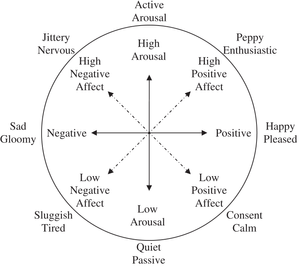Gossip Can Influence Perception
How you feel influences what you see, it is not just what you see that influences how you feel; a top down approach to understanding the visual system.
Affective Circumplex: Affect can vary in terms of valence (positive/negative) and arousal (high/low).
A great analogy for understanding how affect (the experience of an emotion) influences perception is to think of affect as a spotlight, or a source of “attention” that sheds light on the external world. This is known as a top-down process because the cortical and sub cortical levels of the brain directly influence what one externally experiences. This is opposed to a bottom-up process wherein external stimuli influences processing in the brain (an example of this process would be hearing something hit the floor behind you and immediately shifting your attention to that object). The brain uses both of these processes interchangeably, but it has only been recently that a top-down understanding of the visual system (a system that has classically been believed to be primarily regulated by external stimuli and how such stimuli influence attention) has been accepted. Many studies by Lisa Feldman Barrett and the Interdisciplinary Affective Sciences lab at Northeastern University seem to have proved strong evidence against the popular claim that the bottom-up system is the sole means by which perception can be influenced.
Affect has a greater influence on our perception than many would think. If placed in an unpleasant mood state, many people are usually more inclined to attend to smiling, scowling, and neutral faces. If placed in a pleasant mood state, however, people tend to be more inclined to attend to smiling faces. Indeed, during a binocular rivalry test in which a specific face (smiling, scowling or neutral) was presented to one of a test subject’s eyes, and a house to the other, mood induction was shown to determine which face would be viewed. The two percepts in this test compete for visual dominance, and it was apparent that the mood of the test subject directly influenced if the he/she would be more likely to attend to the faces and report whether they viewed a scowling, smiling, or neutral face. This test, and many others, seem to show that our affective state can directly influence what we deem as important to attend to in day to day life. Moreover, Could the gossip of other people, and what they tell us to believe as having “negative” or “positive” connotations truly influence our own sense of perception?
It is surprising to think that something as run of the mill as gossip could influence what we see. But, gossip is a social behavior that provides information (negative or positive) about another person, and thus it makes sense that such information could seep in and influence our perception. As Lisa Feldman Barret states in the video above, a neutral face that was gossiped about negatively was seen more often than a positive face that was gossiped about, a neutral face presented but not gossiped about or a novel face. While it is known that faces are usually more salient to us as a whole since we have evolved to be more attuned to faces, gossiped faces have been shown to be even more salient to us than faces alone. This study seems to show the kind of top down processing that can occur and influence our latent perception of certain things, as previously stored information derived from gossip influences what we tend to attend to, and how we perceive it!
Science: Visual Impact of Gossip – Sciencexpress
The Visual Impact of Gossip (supporting online material) – Science
See it with feeling: affective predictions during object perception – Philosophical Transactions of the Royal Society
What you feel influences what you see: The role of affective feelings in resolving binocular rivalry – Journal of Experimental Psychology

August 29, 2012
I seriously enjoy playing minecraft. This is seriously a game which allows everybody to express their creativeness. I am just so addicted to it!
February 10, 2016
Keep up the superb works guys I’ve included you guys to blogroll.|